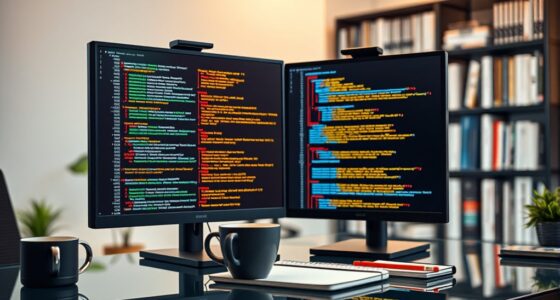To use AI code generators safely, you should combine AI outputs with thorough manual review and testing to catch potential vulnerabilities or ethical issues. Keep the software updated, perform regular security audits, and incorporate static or dynamic analysis tools. Stay transparent with your team about AI use and document your processes. Always treat AI-generated code as a starting point, not a final solution, to guarantee trustworthy results. Continue exploring best practices to maximize safety and ethics.
Key Takeaways
- Conduct thorough manual reviews and testing of AI-generated code before deployment.
- Incorporate security audits and static analysis to identify vulnerabilities in generated code.
- Clearly document AI tool usage and combine outputs with expert oversight for accountability.
- Stay informed about AI limitations, biases, and ethical considerations to mitigate risks.
- Maintain ongoing education and updates on best practices for responsible AI code generation.

As AI code generators become more common in software development, it’s essential to use them responsibly to avoid potential pitfalls. One of the most critical aspects to consider is the ethical considerations surrounding AI-generated code. You need to verify that the code you produce aligns with ethical standards, respects user privacy, and avoids biases that could lead to unfair or harmful outcomes. Relying blindly on AI tools without scrutinizing their outputs can unintentionally introduce security vulnerabilities or ethical lapses. Always review and test AI-generated code thoroughly, and be mindful of the broader implications, like data privacy and user trust. Remember, just because a piece of code is generated quickly doesn’t mean it’s automatically safe or ethically sound.
Security risks are another major concern when integrating AI code generators into your workflow. These tools, while powerful, can sometimes produce code that contains vulnerabilities or exploits, especially if they’re trained on incomplete or biased datasets. You must stay vigilant and never assume that AI-generated code is secure by default. Implement exhaustive security checks, perform regular code audits, and incorporate static and dynamic analysis tools to detect potential flaws. Additionally, keep your AI models updated to minimize the risk of outdated or insecure code suggestions. Your goal should be to treat AI-generated code as a foundation that needs further review, rather than a finished product ready for deployment. Recognizing potential security vulnerabilities in AI-generated code is essential for maintaining a safe development environment.
Another best practice is to maintain transparency about the use of AI in your development process. Inform your team and stakeholders that AI tools are part of your workflow, and document how they’re used. This transparency helps foster accountability and encourages critical oversight, reducing the chance of overlooking security risks or ethical issues. Furthermore, always combine AI-generated code with manual review. AI can accelerate development, but it’s not infallible. Your expertise remains essential in catching issues, especially those related to security and ethics. Cross-check outputs for compliance with your organization’s standards and legal requirements. Incorporating GMC tuning principles—such as thorough testing and validation—can also enhance the reliability of AI-assisted development. Staying informed about the limitations of AI and training data biases is vital for responsible implementation. Additionally, cultivating awareness of the personality traits that influence AI outputs can help developers better interpret and evaluate generated code.
Finally, invest in ongoing education about AI tools and their limitations. Keep yourself and your team informed about the latest developments, best practices, and emerging risks. This proactive approach helps you adapt to the evolving landscape, ensuring you use AI code generators effectively and responsibly. By balancing automation with diligence, you can harness AI’s benefits while safeguarding your projects against ethical pitfalls and security risks. In the end, responsible use of AI code generators isn’t just about efficiency — it’s about building trustworthy, secure software that respects both users and ethical standards.
Frequently Asked Questions
How Do AI Code Generators Impact Software Licensing?
AI code generators can complicate software licensing because they may generate code based on existing intellectual property, raising questions about ownership and licensing agreements. You need to be cautious, as the generated code might infringe on someone’s rights or require you to adhere to specific licenses. Always review the licensing terms of the AI tool and guarantee your use complies with intellectual property laws to avoid legal issues.
Can Ai-Generated Code Introduce Security Vulnerabilities?
Imagine AI-generated code as a skilled but unpredictable apprentice. It can produce excellent work, but without your vigilant oversight, it might introduce security vulnerabilities. Just like an apprentice’s craftsmanship affects the finished masterpiece, code quality depends on your review. You must scrutinize the code, ensuring it’s secure and reliable. Developer oversight is essential to catch potential flaws, safeguarding your project from hidden vulnerabilities that could compromise your entire system.
What Are the Legal Implications of Using Ai-Produced Code?
When you use AI-produced code, you face legal implications around intellectual property rights and liability concerns. You might unknowingly infringe on copyrights or patents, risking legal action. Liability concerns also arise if the code causes security issues or damages. It’s vital to review AI-generated code carefully, guarantee proper licensing, and understand your responsibilities to avoid legal trouble and protect your projects from potential legal claims.
How Do AI Code Generators Handle Proprietary or Sensitive Data?
AI code generators typically prioritize data privacy and protect proprietary or sensitive data by using encryption, anonymization, and strict access controls. They often avoid storing or sharing your data to prevent intellectual property theft. However, you should always review the tool’s privacy policies and guarantee sensitive information isn’t uploaded, as mishandling could compromise data privacy or infringe on intellectual property rights. Staying cautious helps keep your data secure.
What Measures Ensure Ai-Generated Code Complies With Industry Standards?
To guarantee AI-generated code complies with industry standards, you should implement thorough code validation and quality assurance processes. You can review and test the code to identify issues or deviations from standards. Incorporate automated tools for static analysis, security checks, and adherence to coding guidelines. Regularly updating your validation procedures helps catch errors early, ensuring the AI output meets required quality and safety benchmarks effectively.
Conclusion
By following these best practices, you’ll navigate AI code generators like a modern-day Leonardo, blending creativity with caution. Remember, even in the age of AI, a keen eye and responsible use are your best armor—think of it as your trusty sword in the digital domain. Stay vigilant, double-check outputs, and don’t rely solely on automation. With these tips, you’ll harness AI safely and effectively, avoiding the pitfalls of trusting a “magic” scroll.









